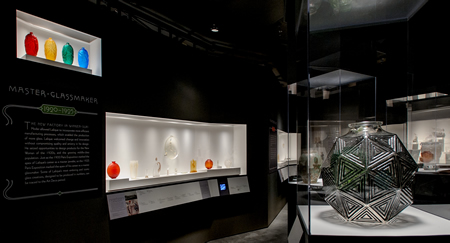
Almost a decade before the birth of Rene Lalique, in a small but burgeoning town a few miles north of Boston, a not quite 40 year old Amory Houghton got in his mind to get in the glass making business. He started with a share in one small local glass company and later acquired other glassmakers. 13 years later, in 1864 Houghton took over the Brooklyn Flint Glass Company in Brooklyn New York. Even with the help of his two sons, the Brooklyn business was financially unstable. And of course the fire was a big problem too. But along came an inspired banker from the small town of Corning New York who convinced the family (naturally money was involved) to move their business to Corning.
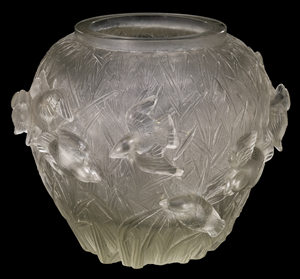 The newly renamed Corning Flint Glass Works was up and operating in 1868, but by 1870 had gone broke. Fortuitously Houghton’s two sons were able to get the business back (sans Houghton Sr.), and succeeded in getting the company on a firmer financial footing, thanks to a small number of products such as colored signal lights for railroads!*
The newly renamed Corning Flint Glass Works was up and operating in 1868, but by 1870 had gone broke. Fortuitously Houghton’s two sons were able to get the business back (sans Houghton Sr.), and succeeded in getting the company on a firmer financial footing, thanks to a small number of products such as colored signal lights for railroads!*
Through the years and plenty of ups and downs, the company has had an amazing run through American history. It worked with Edison on his glass for the light bulb, and for Steve Jobs it developed the glass screens for the iPhone. It created the glass for Liquid Crystal Displays (LCDs) and invented Pyrex. It made the mirror for the Mount Palomar observatory and supplied the glass for the primary mirror in the Hubble Space Telescope. And when responding to a 1960’s era request from the British Post Office for a better and more reliable transmission material, it created the optical fiber that has revolutionized communications. And this is just a small sample of the highlights!
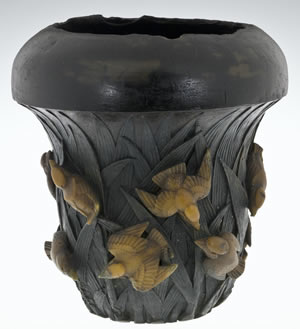 Corning has high tech, high talent, and very low turnover. They are so heavy on innovation and invention, you get the feeling that when a company needs a glass problem solved and approaches Corning, that more often than not a Corning guy in the room says, “We’ve got something on the shelf (from 1, 2, 10, or 20 years ago) we can make work for that.”
Corning has high tech, high talent, and very low turnover. They are so heavy on innovation and invention, you get the feeling that when a company needs a glass problem solved and approaches Corning, that more often than not a Corning guy in the room says, “We’ve got something on the shelf (from 1, 2, 10, or 20 years ago) we can make work for that.”
At Corning’s Sullivan Park Research Center, they obtain something in the neighborhood of 25 patents a month as Corning spends around 9% of all revenue for R&D.
But the company is also strong in community and social works. One such undertaking was conceived to help celebrate the company’s 100th anniversary: the establishment of the Corning Museum of Glass (CMoG) in 1951.
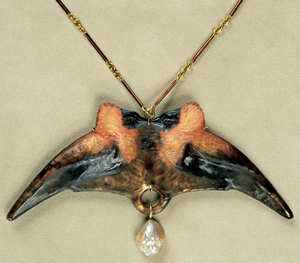 The museum is an independent and not-for-profit organization whose mission it to tell about and keep alive the history and the art of glass. In addition to being an operating museum visited by something like 400,000 people per year, it also holds seminars, classes, demonstrations, workshops, and lectures. It has everything from glassmaking to glass breaking demonstrations, and museum visitors can literally make their own glass as part of their experience at the Corning. On top of all that, the museum is active in both scientific research and publishing on a wide variety of glass related topics.
The museum is an independent and not-for-profit organization whose mission it to tell about and keep alive the history and the art of glass. In addition to being an operating museum visited by something like 400,000 people per year, it also holds seminars, classes, demonstrations, workshops, and lectures. It has everything from glassmaking to glass breaking demonstrations, and museum visitors can literally make their own glass as part of their experience at the Corning. On top of all that, the museum is active in both scientific research and publishing on a wide variety of glass related topics.
All in all, the museum is nearing 50,000 different glass objects in its collection that span roughly 35 centuries of glassmaking.
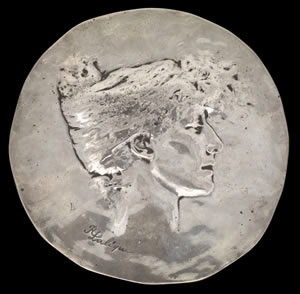 Also part of the museum is the Rakow research library (named after significant benefactors of the museum), the leading research library on glass anywhere in the world. The library has an extensive collection of original period materials on all aspects of glass and glassmaking. Of note is that the collection includes some great original materials related to Rene Lalique (yes, we’re getting to that guy soon:) some of which previously resided right here at World Headquarters! Of course, these are but a small part of the over 2000 documents relating to Lalique’s glass production housed at the Rakow.
Also part of the museum is the Rakow research library (named after significant benefactors of the museum), the leading research library on glass anywhere in the world. The library has an extensive collection of original period materials on all aspects of glass and glassmaking. Of note is that the collection includes some great original materials related to Rene Lalique (yes, we’re getting to that guy soon:) some of which previously resided right here at World Headquarters! Of course, these are but a small part of the over 2000 documents relating to Lalique’s glass production housed at the Rakow.
Of the tens of thousand of objects at the Corning, until recently only about 200 were directly related to Rene Lalique. Over half of those were acquired in the early 1980’s, comprising rare models and prototypes (work pieces) which had been kept together by a Rene Lalique et Cie factory supervisor from the period.
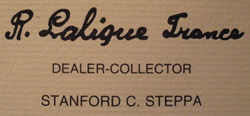 But in 2011, Stanford and Elaine Steppa, New Jersey residents with a longtime involvement in the works of the great Lalique, donated about 400 items to the museum. Most of the items were commercial production pieces, which by their numbers sampled the largest part of the gamut, in time and types, of Lalique’s commercial works. And there were also a few amazing rare unique and nearly unique items as well.
But in 2011, Stanford and Elaine Steppa, New Jersey residents with a longtime involvement in the works of the great Lalique, donated about 400 items to the museum. Most of the items were commercial production pieces, which by their numbers sampled the largest part of the gamut, in time and types, of Lalique’s commercial works. And there were also a few amazing rare unique and nearly unique items as well.
So now with around 600 pieces representing everything from the conception to the process to the results, the reference material to back stop it all, and the ability to borrow objects to fill in a random blank or two**; suddenly the story appears in the totality of the materials and objects.
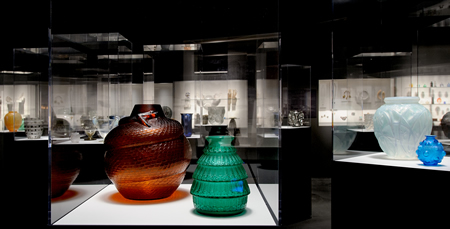
Suddenly, it’s not a good looking glass vase from 1922; it’s the story of the artist and his design development and influences (the swans on the pond or the birds in the trees at the country house). It’s how the glass thing got started (the jewelry, the bottles), how it was industrialized (the models, the patents), how the art was conceived (the drawings) and with what means and what steps (the work pieces) the final object was created. Suddenly, what we call a story, they call an exhibition!
It’s the visual and referential story of Rene Lalique, told one piece at a time through about 200 objects, and amazing period reference material. It’s “Rene Lalique: Enchanted by Glass” at the Corning.
The exhibition is already up and open (as of Saturday May 17th) and will continue through January 4th, 2015.
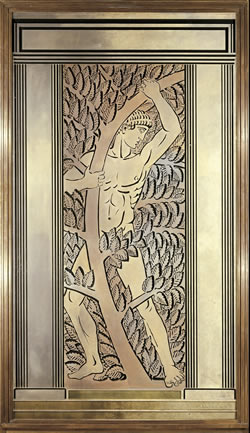 Our takeaway*** from an in-depth interview with the exhibition curator Kelley Jo Elliot**** can be boiled to down to one overriding message. The purpose of the exhibition is to tell the story. From the Cire Perdue Vase, to tell how he did it and how it came to be. From the 1893 exhibition medal, to tell what his goals were, what was important to him, and how he was trying to achieve his aims. From the round green glass invitation medallion, to show his technique and his touch. And from the iconic commercial R. Lalique items such as the Serpent Vase, the Tourbillons Vase, or the Suzanne Statue, to be able to explain in the context of Lalique, his world and his history, how these wonderful art glass pieces were developed.
Our takeaway*** from an in-depth interview with the exhibition curator Kelley Jo Elliot**** can be boiled to down to one overriding message. The purpose of the exhibition is to tell the story. From the Cire Perdue Vase, to tell how he did it and how it came to be. From the 1893 exhibition medal, to tell what his goals were, what was important to him, and how he was trying to achieve his aims. From the round green glass invitation medallion, to show his technique and his touch. And from the iconic commercial R. Lalique items such as the Serpent Vase, the Tourbillons Vase, or the Suzanne Statue, to be able to explain in the context of Lalique, his world and his history, how these wonderful art glass pieces were developed.
To help put it all in perspective the exhibition is organized in a couple of ways, including by timeline. So the visitor can see the development of Lalique from unique jewelry all the way to the later big architectural pieces; which would include by the way, the amazing 1932 figural panel from the Wanamaker’s store in Philadelphia.
The museum is located in the Finger Lakes***** region of New York State. It’s 4 or 5 hours drive from NYC, and about the same from Washington D.C.. From Niagara Falls it’s about 3 hours. The closest decent size city is Ithaca, home to Cornell University. And there is small regional airport (Elmira/Corning) that is only about a 15 minute drive (paid shuttle available) to the museum that has flights from Detroit, Philadelphia, Chicago, and Orlando.
The exhibition is included as part of the general museum visitor charge. The museum is open 7 days a week from 9:00 AM to 8:00 PM during the summer, but after Labor Day the closing time moves up to 5:00 PM. Further details can be found at the museum website.
In conjunction with the exhibition, the museum has also published a thoughtful and informative nearly 400 page reference book about Rene Lalique and the Corning, containing hundreds of photos of both commercial and unique pieces, and pictures of a large number of original models. The book is coincidentally titled “Rene Lalique Enchanted by Glass”. Shown here from the book, in addition to a photo of the dust jacket, is a photo of the extremely rare non-commercial Levrier Car Mascot created as a gift for the Prince of Wales in 1929, next to a photo of an original plaster model for that mascot. Who else but the Corning can tell the story like this? The book is out of print, but check the library here on the site or write us directly about getting you one.
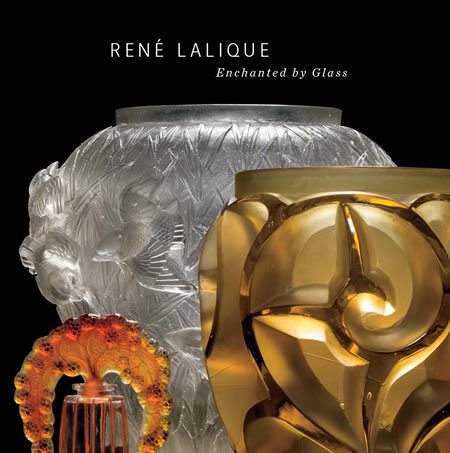
Our final thoughts:
This is not a show where a bunch of brightly colored vases, some valuable jewelry and a few unique objects are tossed together and the exhibitor is just saying, “Hey, look at this, didn’t this guy make cool stuff”. The Corning is fortunately situated with its collection and resources to bring this stuff to life, and to put it in perspective and context historically, educationally, artistically and industrially. It’s a great opportunity for anyone interested in the Rene Lalique and his works. And heck, it’s just an added kicker that the Finger Lakes region of New York is a great place to visit in the summertime!
* Persistence paid off for the Houghton clan. The 1957 Forbes Magazine list of the 76 richest Americans listed both Amory Houghton and Arthur A. Houghton Jr. at between 100 million and 200 million dollars each. In today’s dollars that’s in the billion range (give or take a few hundred million of course).
** Included in the exhibition are 14 unique items (designs, objects, jewelry) on loan from other museums. The lenders are the Calouste Gulbenkian in Lisbon Portugal; the Chazen in Madison Wisconsin; The Walters in Baltimore Maryland, the VMFA in Richmond Virginia; the Smithsonian in Washington D.C.; and the Musée des arts décoratifs in Paris, France. All are linked from our page listing over 80 museums around the world containing the works of Rene Lalique.
*** The “takeaway” is not a quote. It’s more like the gist, the central point, or the main idea as we took it.
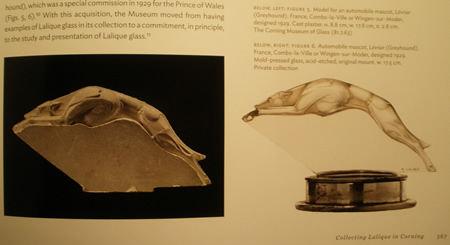
**** Kelley is the Assistant Curator of Modern and Contemporary Glass at the Corning. She has a Fine Art Bachelor’s degree and a Master’s in Decorative Arts History and has worked with a range of museums. She has a strong interest and background in the works of Rene Lalique and in the French artistic glass and jewelry milieu from which he emerged.
***** The Finger Lakes region of New York State is so named because of the pattern of a string of long narrow (and narrowing) lakes which run down from below the New York State Thruway (AKA I-90 or the Thomas E Dewey Thruway) roughly bounded by I-390 in the west and I-81 in the east; kind of in-between but below Rochester and Syracuse. The lakes look like fingers on a map.
All Articles on These Topics: R Lalique Exhibitions and Rene Lalique Exhibitions, Rene Lalique Biography


Hi Greg and all Lalique collectors, I don’t often comment but I do keep a close eye on all the amazing information on this site! Greg, I was looking up an older posting (2012) regarding the Renard Car mascot that appeared at Bonhams soon after a world record price was achieved for the Du Pont Renard Mascot. The difference was the Bonhams one was signed with an acid etched signature. I looked at the Bonhams site directly and was struck by the suspicious appearance of that signature! You have always said the piece should verify the signature and not visa versa. Am I being overly suspicious to suggest the Renard mascot at Bonhams was totally authentic but the signature is not? I would love to know your thoughts on this.
Cheers from the Antipodes.